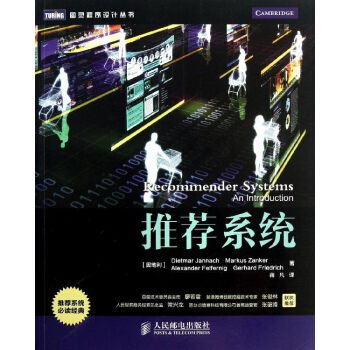![Python机器学习(影印版) [Python Machine Learning]](https://pic.windowsfront.com/12205192/5943a1beN72d89975.jpg)

具体描述
内容简介
机器学习和预测分析正在改变商业和其他组织的运作模式。《Python机器学习(影印版)》将带你进入预测分析的世界,通过演示告诉你为什么Python是世界数据科学语言之一。如果你想询问更深入的数据问题,或是想增进、拓展机器学习系统的能力,这本实用的书籍可谓是无价之宝。
《Python机器学习(影印版)》涵盖了包括scikit-learn、Theano和Keras在内的大量功能强大的Python库、操作指南以及从情感分析到神经网络的各色小技巧,很快你就能够解答你个人及组织所面对的那些*重要的问题。
作者简介
Sebastian Raschka,a PhD student at Michigan State University, who develops new computational methods in the field of computational biology. He has been ranked as the number one most influential data scientist on GitHub by Analytics Vidhya. He has a yearlong experience in Python programming and he has conducted several seminars on the practical applications of data science and machine learning. Talking and writing about data science, machine learning, and Python really motivated Sebastian to write this book in order to help people develop data-driven solutions without necessarily needing to have a machine learning background. He has also actively contributed to open source projects and methods that he implemented, which are now successfully used in machine learning competitions, such as Kaggle. In his free time, he works on models for sports predictions, and if he is not in front of the computer, he enjoys playing sports.内页插图
目录
PrefaceChapter 1: Givin Computers the Ability to Learn from Data
Building intelligent machines to transform data into knowledge
The three different types of machine learning
Making predictions about the future with supervised learning
Classification for predicting class labels
Regression for predicting continuous outcomes
Solving interactive problems with reinforcement learning
Discovering hidden structures with unsupervised learning
Finding subgroups with clustering
Dimensionality reduction for data compression
An introduction to the basic terminology and notations
A roadmap for building machine learning systems
Preprocessing-getting data into shape
Training and selecting a predictive model
Evaluating models and predicting unseen data instances
Using Python for machine learning
Installing Python packages
Summary
Chapter 2: Training Machine Learning Algorithms
for Classification
Artificial neurons-a brief glimpse into the early history
of machine learning
Implementing a perceptron learning algorithm in Python
Training a perceptron model on the Iris dataset
Adaptive linear neurons and the convergence of learning
Minimizing cost functions with gradient descent
Implementing an Adaptive Linear Neuron in Python
Large scale machine learning and stochastic gradient descent
Summary
Chapter 3: A Tour of Machine Learning Classifiers Using
Scikit-learn
Choosing a classification algorithm
First steps with scikit-learn
Training a perceptron via scikit-learn
Modeling class probabilities via logistic regression
Logistic regression intuition and conditional probabilities
Learning the weights of the logistic cost function
Training a logistic regression model with scikit-learn
Tackling overfitting via regularization
Maximum margin classification with support vector machines
Maximum margin intuition
Dealing with the nonlinearly separablecase using slack variables
Alternative implementations in scikit-learn
Solving nonlinear problems using a kernel SMM
Using the kernel trick to find separating hyperplanes in higher
dimensional space
Decision tree learning
Maximizing information gain-getting the most bang for the buck
Building a decision tree
Combining weak to strong learners via random forests
K-nearest neighbors-a lazy learning algorithm
Summary
Chapter 4: Building Good Training Sets-Data Preprocessing
Dealing with missing data
Eliminating samples or features with missing values
Imputing missing values
Understanding the scikit-learn estimator API
Handling categorical data
Mapping ordinal features
Encoding class labels
Performing one-hot encoding on nominal features
Partitioning a dataset in training and test sets
Bringing features onto the same scale
Selecting meaningful features
Sparse solutions with L1 regularization
Sequential feature selection algorithms
Assessing feature importance with random forests
Summary
Chapter 5: Com~ Data via Di~ Reduction
Unsupervised dimensionality reduction via principal
component analysis
Total and explained variance
Feature transformation
Principal component analysis in scikit-learn
Supervised data compression via linear discriminant analysis
Computing the scatter matrices
Selecting linear discriminants for the new feature subspace
Projecting samples onto the new feature space
LDA via scikit-learn
Using kernel principal component analysis for nonlinear mappings
Kernel functions and the kernel trick
Implementing a kernel principal component analysis in Python
Example 1-separating half-moon shapes
Example 2-separating concentric circles
Projecting new data points
Kernel principal component analysis in scikit-learn
Summary
Chapter 6: Learning Best Practices for Model Evaluation
and Hyperparameter Tuni~
Streamlining workflows with pipelines
Loading the Breast Cancer Wisconsin dataset
Combining transformers and estimators in a pipeline
Using k-fold cross-validation to assess model performance
The holdout method
K-fold cross-validation
Debugging algorithms with learning and validation curves
Diagnosing bias and variance problems with learning curves
Addressing overfitting and underfitting with validation curves
Fine-tuning machine learning models via grid search
Tuning hyperparameters via grid search
Algorithm selection with nested cross-validation
Looking at different performance evaluation metrics
Reading a confusion matrix
Optimizing the precision and recall of a classification model
Plotting a receiver operating characteristic
The scoring metrics for multiclass classification
Summary
Chapter 7: Combining Different Models for Ensemble Learning
Learning with ensembles
Implementing a simple majority vote classifier
Combining different algorithms for classification with majority vote
Evaluating and tuning the ensemble classifier
Bagging-building an ensemble of classifiers from
bootstrap samples
Leveraging weak learners via adaptive boosting
Summary
Chapter 8: Applying Machine Learning to Sentiment Analysis
Obtaining the IMDb movie review dataset
Introducing the bag-of-words model
Transforming words into feature vectors
Assessing word relevancy via term frequency-inverse
document frequency
Cleaning text data
Processing documents into tokens
Training a logistic regression model for document classification
Working with bigger data-online algorithms and
out-of-core learning
Summary
Chapter 9: Embedding a Machine Learning Model into
a Web Application
Serializing fitted scikit-learn estimators
Setting up a SQLite database for data storage
Developing a web application with Flask
Our first Flask web application
Form validation and rendering
Turning the movie classifier into a web application
Deploying the web application to a public sewer
Updating the movie review classifier
Summary
Chapter 10: Predicting Continuous Target Variables
with R_Re_gression Analysis
Introducing a simple linear regression model
Exploring the Housing Dataset
Visualizing the important characteristics of a dataset
Implementing an ordinary least squares linear regression model
Solving regression for regression parameters with gradient descent
Estimating the coefficient of a regression model via scikit-learn
Fitting a robust regression model using RANSAC
Evaluating the performance of linear regression models
Using regularized methods for regression
Turning a linear regression model into a curve-polynomial regression
Modeling nonlinear relationships in the Housing Dataset
Dealing with nonlinear relationships using random forests
Decision tree regression
Random forest regression
Summary
Chapter 11: Working with Unlabeled Data- Cluste~
Grouping objects by similarity using k-means
K-means++
Hard versus soft clustering
Using the elbow method to find the optimal number of clusters
Quantifying the quality of clustering via silhouette plots
Organizing clusters as a hierarchical tree
Performing hierarchical clustering on a distance matrix
Attaching dendrograms to a heat map
Applying agglomerative clustering via scikit-learn
Locating regions of high density via DBSCAN
Summary
Chapter 12: Training Artificial Neural Networks for Image Recognition
Modeling complex functions with artificial neural networks
Single-layer neural network recap
Introducing the multi-layer neural network architecture
Activating a neural network via forward propagation
Classifying handwritten digits
Obtaining the MNIST dataset
Implementing a multi-layer perceptron
Training an artificial neural network
Computing the logistic cost function
Training neural networks via backpropagation
Developing your intuition for backpropagation
Debugging neural networks with gradient checking
Convergence in neural networks
Other neural network architectures
Convolutional Neural Networks
Recurrent Neural Networks
A few last words about neural network implementation
Summary
Chapter 13: Parallelizing Neural Network Training with Theano
Building, compiling, and running expressions with Theano
What is Theano?
First steps with Theano
Configuring Theano
Working with array structures
Wrapping things up-a linear regression example
Choosing activation functions for feedforward neural networks
Logistic function recap
Estimating probabilities in multi-class classification via the
softmax function
Broadening the output spectrum by using a hyperbolic tangent
Training neural networks efficiently using Keras
Summary
Index
前言/序言
We live in the midst of a data deluge. According to recent estimates, 2.5 quintillion (10i8) bytes of data are generated on a daily basis. This is so much data that over 90 percent of the information that we store nowadays was generated in the past decade alone. Unfortunately, most of this information cannot be used by humans. Either the data is beyond the means of standard analytical methods, or it is simply too vast for our limited minds to even comprehend.Through Machine Learning, we enable computers to process, learn from, and draw actionable insights out of the otherwise impenetrable walls of big data. From the massive supercomputers that support Google s search engines to the smart phones that we carry in our pockets, we rely on Machine Learning to power most of the world around us - often, without even knowing it.
As modem pioneers in the brave new world of big data, it then behooves us to learn more about Machine Learning. What is Machine Learning and how does it work? How can I use Machine Learning to take a glimpse into the unknown, power my business, or just find out what the Internet at large thinks about my favorite movie? All of this and more will be covered in the following chapters authored by my good friend and colleague, Sebastian Raschka. When away from taming my otherwise irascible pet dog, Sebashan has tirelessly devoted his free time to the open source Machine Learning community. Over the past several years, Sebastian has developed dozens of popular tutorials that cover topics in Machine Learning and data visualization in Python. He has also developed and contributed to several open source Python packages, several of which are now part of the core Python Machine Learning workflow.
Owing to his vast expertise in this field, I am confident that Sebashan's insights into the world of Machine Learning in Python will be invaluable to users of all experience levels. l wholeheartedly recommendy this book to anyone looking to gain a broader and more practical und Yerstanding of Machine Learning.
用户评价
我一直觉得,学习一门新的技术,最怕的就是陷入“理论的海洋”而无法自拔,或者反过来,只停留在“调包侠”的层面,对背后的原理一无所知。这本《Python机器学习(影印版) [Python Machine Learning]》似乎找到了一个很好的平衡点。它在介绍算法时,既有必要的理论铺垫,让你理解算法是如何工作的,又有丰富的Python代码示例,让你能够立刻动手实践。我尤其喜欢书中对各种监督学习和无监督学习算法的对比分析,比如在什么时候选择线性模型,什么时候选择基于树的模型,又或者在聚类分析中,不同算法的适用场景和优缺点。这种宏观的比较和微观的细节相结合的方式,让我对机器学习算法的整体框架有了更清晰的认识。影印版虽然是全英文的,但对于我这种习惯阅读英文技术文档的读者来说,反而是一种便利,可以直接接触到原汁原味的技术表达。我已经迫不及待地想要深入研究其中的实践章节,希望能通过这本书,真正将理论知识转化为解决实际问题的能力。
评分作为一名对技术迭代保持高度敏感的从业者,寻找一本能够跟上时代步伐的机器学习书籍一直是我关注的重点。这本《Python机器学习(影印版) [Python Machine Learning]》在这一点上给了我很大的惊喜。它不仅仅是罗列各种算法,更重要的是,它能让你理解算法背后的数学原理,以及如何在Python的生态系统(比如NumPy, SciPy, Scikit-learn等库)中有效地实现它们。我特别欣赏书中对数据预处理和特征工程的详细阐述,这在实际应用中往往是决定模型成败的关键一步。从缺失值处理、异常值检测,到各种特征变换和特征选择方法,书中都给出了细致的讲解和代码演示。这让我意识到,机器学习并非仅仅是调用几个函数那么简单,前期的准备工作同样重要。虽然是影印版,但整体阅读体验还是非常流畅的,关键在于其内容的高价值。我目前正在攻克其中的深度学习部分,看到它对多层感知机、卷积神经网络的介绍,感觉内容非常前沿,希望能从中汲取养分,为我今后的项目开发提供更强大的技术支持。
评分最近一直在寻找一本能够系统性梳理机器学习知识体系的书籍,最终选择了这本《Python机器学习(影印版) [Python Machine Learning]》。这本书给我最深刻的印象是它的条理性非常强。从数据获取、预处理,到模型选择、训练、评估,再到模型部署,它几乎涵盖了机器学习项目开发的整个生命周期。书中的案例非常有代表性,能够让你在学习理论的同时,也能看到实际应用中的挑战和解决方案。我特别关注的是书中关于模型解释性的讨论,这在很多机器学习书籍中是被忽视的,但对于理解模型行为、排查问题以及向业务方解释模型结果都至关重要。影印版的阅读体验虽然需要一定的英文基础,但其内容的深度和广度是毋庸置疑的。我计划将这本书作为我的主参考书,一步步地深入学习,并尝试将书中的技术应用到我目前正在进行的一些数据分析项目中,相信它能为我的机器学习技能提升带来显著的帮助。
评分拿到这本《Python机器学习(影印版) [Python Machine Learning]》的时候,说实话,我的内心是有些期待又有些忐忑的。作为一名对机器学习领域跃跃欲试的开发者,市面上关于Python机器学习的书籍琳琅满目,但很多要么过于理论化,要么细节不够深入,很难真正将知识转化为实践。这本影印版,首先在装帧上就透露出一种厚重感,纸张的质感和印刷的清晰度都相当不错,这一点对于长时间阅读来说是个加分项。我初步翻阅了一下目录,发现它涵盖了从基础的线性回归、逻辑回归,到更复杂的支持向量机、决策树、随机森林,乃至深度学习中的神经网络等核心概念,这让我对它的系统性有了初步的信心。更重要的是,它强调的是Python在机器学习中的应用,这意味着我可以借助熟悉的环境和工具,更直观地理解和实现这些算法。我尤其关注的是书中对各个算法的推导过程和代码实现部分,希望能从中找到清晰的逻辑脉络,不仅仅是“怎么做”,更能理解“为什么这么做”,从而建立起扎实的理论基础。目前,我还在逐步深入阅读中,但从初步的印象来看,这本书很有潜力成为我机器学习学习之旅中的重要指引。
评分坦白说,我买这本《Python机器学习(影印版) [Python Machine Learning]》主要还是冲着它在业界的口碑来的。身边有几个做数据科学的朋友都推荐过,说它的内容更新比较及时,而且讲解方式比较易懂,尤其适合有一定Python基础但初涉机器学习的读者。拿到书后,我迫不及待地翻到关于模型评估和选择那一章,因为这是我在实际项目中常常会遇到的瓶颈。书中对各种评估指标,如准确率、召回率、F1分数、ROC曲线等的解释非常清晰,并且给出了相应的Python代码示例,让我能够快速地在自己的数据集上进行尝试。更让我惊喜的是,它还讲解了交叉验证、网格搜索等重要的模型调优技术,这些技巧对于提升模型的性能至关重要。虽然是影印版,但内容质量丝毫不打折扣,印刷清晰,排版也很合理,读起来不会感到吃力。我打算按照书中的章节顺序,结合实际项目需求,一步步地学习和实践,希望能通过这本书,真正掌握利用Python构建高效机器学习模型的方法,让我的工作效率更上一层楼。
评分纸质不错
评分东西已收到,看着还不错
评分书籍质量不错,经典
评分很不错的Python机器学习书,网上推荐的,赞!
评分书是好书,结合python3使用,应该能丰富业余生活。
评分很不错的Python机器学习书,网上推荐的,赞!
评分书籍很好,非常适合学习,推荐购买
评分一直在京东买书,方便快捷
评分一直在京东买书,方便快捷
相关图书
本站所有内容均为互联网搜索引擎提供的公开搜索信息,本站不存储任何数据与内容,任何内容与数据均与本站无关,如有需要请联系相关搜索引擎包括但不限于百度,google,bing,sogou 等
© 2025 book.coffeedeals.club All Rights Reserved. 静流书站 版权所有




![[按需印刷] 量子计算机研究(下册)纠错和容错计算 pdf epub mobi 电子书 下载](https://pic.windowsfront.com/10241970896/5705ce01N3fd69d83.jpg)















